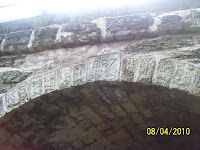
When was the South Street Tunnel built? Who knows? How sharp are your eyes? Do you pay attention to details?
Recently a McHenry friend was visiting Woodstock, not for the first time. She often drives "the back way" from the old Jewel to South Street. That's along Lake Street (not Avenue!) to the stop sign; then left and through the tunnel, and west on South Street (figure that one out).
Last week she photographed both sides of the tunnel. Check the dates  on the keystones! On one side the date on the keystone is 1867; on the other side, 1897! Click on the image to enlarge it (then click on the Back button on your browser to return here).
on the keystones! On one side the date on the keystone is 1867; on the other side, 1897! Click on the image to enlarge it (then click on the Back button on your browser to return here).
 on the keystones! On one side the date on the keystone is 1867; on the other side, 1897! Click on the image to enlarge it (then click on the Back button on your browser to return here).
on the keystones! On one side the date on the keystone is 1867; on the other side, 1897! Click on the image to enlarge it (then click on the Back button on your browser to return here).Allen Stebbins, Chair of the Woodstock Historic Preservation Commission, provided this insight to the tunnel (or "Culvert"):
"The South St. Culvert as it has been called was built in two sections. The first in 1867 when the Chicago & Northwestern built a single rail line out this way and the second section 30 years later in 1897 when they expanded to a second line. That's why the two dates on the keystones. I've started collecting some historic records on this bridge.
"What's unusual is both sections were built in what's known as a helicoidal or spiral arch method. These arches are extremely rare in the United States built when a road or railroad crossed another road or river at an angle and at an incline. It posed some real problems for the engineers who looked back to the ancient Romans for ideas to solve the problem and rediscovered the spiral arch! Basically all the engineering up front needed to be pretty precise and once designed the stonemasons cut all the stones exactly the same dimensions then laid them in the spiral arch (oftentimes without the need of any mortar.) These types of arches are extremely strong and durable as witnessed by some of the ancient Roman examples still standing.
"In the United States there are only a few known examples–some in Pennsylvania and the Seventh Street Improvement Arches in Minneapolis. These are listed as landmarks on the National Register of Historic Places. The South St. Culvert is in the historic district and I would like to see it nominated as a national landmark, but do know Union Pacific opposes it. They do have plans in the future to expand the rail lines to three from Barrington all the way out to Harvard when they ultimately put in the Woodstock rail yard. ..."
"What's unusual is both sections were built in what's known as a helicoidal or spiral arch method. These arches are extremely rare in the United States built when a road or railroad crossed another road or river at an angle and at an incline. It posed some real problems for the engineers who looked back to the ancient Romans for ideas to solve the problem and rediscovered the spiral arch! Basically all the engineering up front needed to be pretty precise and once designed the stonemasons cut all the stones exactly the same dimensions then laid them in the spiral arch (oftentimes without the need of any mortar.) These types of arches are extremely strong and durable as witnessed by some of the ancient Roman examples still standing.
"In the United States there are only a few known examples–some in Pennsylvania and the Seventh Street Improvement Arches in Minneapolis. These are listed as landmarks on the National Register of Historic Places. The South St. Culvert is in the historic district and I would like to see it nominated as a national landmark, but do know Union Pacific opposes it. They do have plans in the future to expand the rail lines to three from Barrington all the way out to Harvard when they ultimately put in the Woodstock rail yard. ..."
The tunnel is architecturally and historically significant. The tunnel should be designated a Landmark by the City of Woodstock and preserved, as is the Woodstock Opera House.
Note the City's motto: "True to its past...confident of its future." Will The People prevail in the case of preserving the tunnel, or will the tunnel meet the same fate as Grace Hall?"

No comments:
Post a Comment